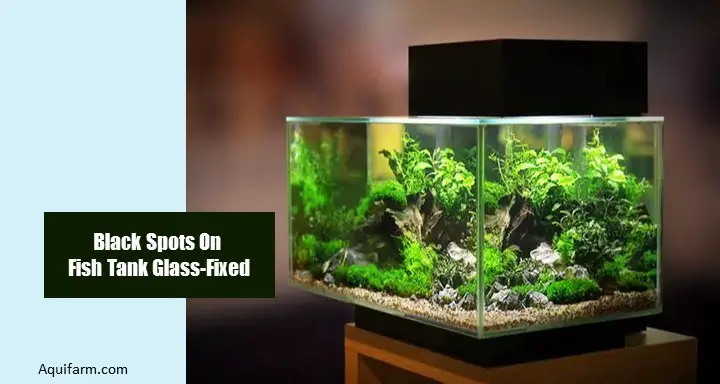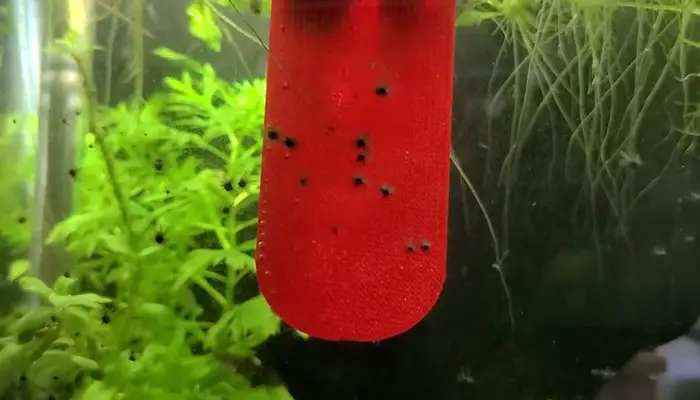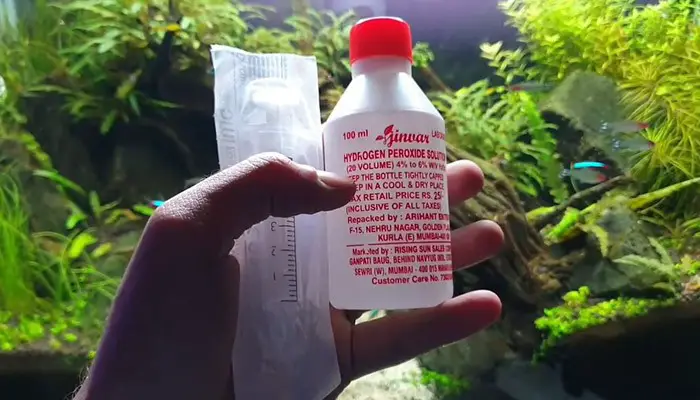
An aquarium with exotic fishes and colorful decorations is enough to lighten up your living room. Besides, if you have a goldfish or a clownfish as a pet, then a fish tank is a must.
Sometimes you may wonder why you see black spots on fish tank glass. Typically, the black brush algae, diatoms, and phosphate cause these black spots. Unclean substrate and polluted waters are suitable environments for diatoms and black algae.
So, you have to clean the fish tank glass regularly to keep the fish and the overall aquatic environment healthy. Otherwise, some dangerous bacteria and viruses can easily attack the animals.
This article will show you the three main causes behind black spots on aquarium glass and how to remove them.
So, let’s get started.
Why Are There Black Spots In My Aquarium?

If you notice some dark spots on your fish tank glass, the first question you will ask yourself is- why does my fish tank have black spots? For this purpose, we have done deep research and found three root causes behind it.
So, keep reading to know the causes and their solutions.
1. Phosphate
The high phosphate and nitrate level not only harms the aquatic animals but also creates black spots on the fish tank glass. Besides, phosphate is responsible for the birth of many harmful bacteria and parasites.
Typically, the natural waste breakdown including dead plants, uneaten food, and fish excrement increases the phosphate level in the aquarium water. As a result, it leaves dark spots on the living plants, fish, and also fish tank glass.
If the phosphate increases rapidly, it will decrease the oxygen level in the water and produce algae. Thus it will create a harmful environment for your aquatic pets.
If you notice black spots on the fish tank glass, you have to test the nitrate and phosphate levels to make sure that phosphate is the actual reason for that. So, you can use nitrate and phosphate aquarium test kits to do that. (Our Pick: API Phosphate Test Kit For Freshwater And Saltwater)
Moreover, we feel like reminding you that nitrates and phosphates are harmful at over 50mg/l. So, take action instantly if the test kit shows you a high phosphate level.
Solution
You need to take immediate action after finding out about the high phosphate level in the fish tank water. In this case, the steps below will help you to remove the phosphate from the aquarium glass-
- You should start with 25% of water change if you detect a high level of nitrates and phosphate.
- Add fresh filtered water to the fish tank. At this time, you can also put the pets into another container to avoid further trouble.
- Clean the substrate with a gravel cleaner. (our pick: hygger Aquarium Gravel Cleaner)
- You can use a brush to clean the fish tank glass.
- Add a phosphate-absorbing filter media with the aquarium. (our pick: Fluval ClearMax Phosphate Remover)
- If those steps don’t work effectively, use some chemical additives to decrease the phosphate level. (our pick: D-D Rowahos Phosphate Remover for Aquarium)
The nitrate and phosphate absorbing filter media work great against the high nitrate and phosphate levels in the aquarium water. However, remember to apply it as a last resort to eliminate the excessive phosphate from the fish tank.
2. Black Beard Algae
The black spots you see on your aquarium glass can be the black beard algae. Especially, if those spots look hairy, they are black beard or black brush algae.
Typically, the black beard algae belong to the red algae family. Although it looks dark green or deep black, it will turn red if you pour alcohol on it. In addition, it tends to cling to the aquarium wall or ground strongly.
There are some common causes below for growing black algae in the fish tank glass-
- Overfeeding;
- Too much fish in the fish tank;
- Organic waste;
- Carbon dioxide deficiency;
- No plants or too many plants in the aquarium.
The black algae don’t cause any serious harm to the aquarium environment. However, excessive black algae aren’t good for aquatic animals. Besides, it blocks the sunlight and restrains the photosynthesis system.
Solution
It’s not an easy task to clean the black algae from the fish tank. But we will help you clean these horrible algae from your aquarium glass.
Remove Phosphate
Phosphate is the main cause behind the black spots on fish tank glass. So, cleaning phosphate from the aquarium is a must.
To do this, you need to change the water. But make sure that the water you add to the fish tank is phosphate-free. Besides, you can also add a phosphate-absorbing filter to your aquarium.
Clean The Organic Waste
If you don’t clean the aquarium regularly, it will produce many harmful parasites and bacteria including black beard algae.
So, if you notice some black algae on your fish tank glass, clean the waste food and other dirt from the aquarium glass and substrate. Besides, you can use a gravel cleaner to vacuum the organic waste.
Apply Hydrogen Peroxide

Hydrogen peroxide works best for removing black beard algae from the fish tank. So, you can treat the whole aquarium with a 3% hydrogen peroxide solution. (Our Pick: Amazon Basics Hydrogen Peroxide)
For this purpose, add 10ml of 3% hydrogen peroxide solution to a 15 gallons fish tank. In this process, all the black algae will be eliminated within a few days. If you still notice some of them, then you may need a slightly high dose of hydrogen peroxide.
Typically, the hydrogen peroxide solution doesn’t affect the plants and fish in the fish tank. But you put the animals somewhere else while applying it in the aquarium.
Inject Carbon Dioxide
Since the lack of carbon dioxide produces the black beard algae in the fish tank, injecting carbon dioxide is another effective solution for cleaning black algae from the fish tank glass. (Our Pick: FZONE 2.5L Aquarium CO2 Generator System)
But you must remove the fish and living plants from the fish tank because this injection can be extremely harmful to the animals. Besides, you may also need to check out the aquarium lighting and water volume in the fish tank while injecting carbon dioxide.
3. Diatoms
One of the common causes of dark spots in the fish tank glass is brown algae. Then again, diatoms are the brown silica algae that cause black or dark brown spots on the aquarium glass in most cases.
The diatoms usually belong to the Bacillariophyceae family. It can be found in both freshwater and saltwater aquariums. In addition, the slime-like silica covers the plants, decorations, and aquarium glass in the fish tank.
The most common reason for growing diatoms is a brand new aquarium. Besides, water is one of the main issues. Especially, tap water contains too many nitrates and silica which produce the diatoms later in the fish tank.
Moreover, lack of enough sunlight is another reason for any kind of brown algae including diatoms. Although the diatoms cause no harm to the fish and other aquatic animals, they make the whole fish tank pretty much ugly.
Solution
Needless to say, cleaning the diatoms from the aquarium glass is one of the easiest tasks you have ever done! You can only use an extended scraper to get rid of it.
So, you can follow the straightforward steps below to clean the brown silica algae from your fish tank glass.
Step 1
Since regular tap water contains silica and nitrate that causes diatoms, water filtration is the first step to removing the diatoms. For this purpose, you can add a good aquarium filter to your fish tank. Besides, you can also change the tap water with RO water.
Step 2
Diatoms are very weak objects and they can’t swim. So, water movement can be a great help to get rid of it. Besides, the water movement helps to maintain the water filtration in the fish tank.
To do this, you can add the current makers or powerheads to your aquarium. It will create constant water movement in the fish tank. (Our Pick: AQUANEAT Circulation Pump, Aquarium Wave Maker)
Step 3
The most important step is to scrub the fish tank glass with a good scraper for cleaning the diatoms. But before that, remove all the animals, plants, and decorations from the aquarium.
Firstly, wear a pair of hand gloves and take a scraper. Then, scrub the fish tank glass carefully. You can also use some bleach while scrubbing. Finally, scratch the stones and plants swiftly if they also get diatoms.
Step 4
You have to change the water as the last step of cleaning the diatoms from the fish tank glass. Change the water from 30% up to 50%. After that, you can safely bring back all the animals and plants in the aquarium.
Prevention
No one likes to see black spots on their fish tank glass. It not only makes the aquarium look ugly but also unhygienic to the plants and fish. So, some extra care can easily prevent this problem.
Stop Wasting Food
Overfeeding aquatic animals causes many problems including high phosphate levels and many harmful parasites. As a result, your aquarium glass may get black spots.
So, you need to stop wasting food while feeding your pets. For this purpose, you can observe the eating habits of the fish. For example, take a close look at how much they eat within 2-3 minutes. Thus you can estimate the actual amount of food that your fish eats daily.
Leave Enough Space for Each Pet
You need to make sure that you don’t flood your aquarium with too many fish. Otherwise, more organic waste will be produced, and thus the nitrate and phosphate levels will be high.
So, don’t crowd the fish tank with too many fish to prevent the black spots on the aquarium glass.
Keep an Algae Eating Fish
Some aquatic fishes like to eat algae. For example, if you keep black algae eating fish in your aquarium, it will eat up all algae that grow in the fish tank.
Thus it can prevent the growth of black spots on fish tank glass caused by black algae. Some black algae-eating fishes are- flying fox fish, Chinese algae eaters, black molly, rosy barb, and much more.
Water Filter
The high phosphate level is the cause of the growing algae and many bacteria in the aquarium. So, a phosphate and nitrate absorbing filter can reduce this problem. It will maintain a proper phosphate and nitrate balance in the fish tank.
Sufficient Lighting
You need to provide enough light to the fish tank. It’s because placing the aquarium in a dark area increases the chance of growing phosphate and black algae. As a result, it creates black spots on fish tank glass.
So, make sure that the fish tank gets sufficient light every day.
Frequently Asked Questions
Are Diatoms Dangerous?
The diatoms are silica-based brown algae. Typically, they are not harmful to any aquatic animal or plant. Moreover, some fish like to eat diatoms. But it’s still not a good thing for an aquarium environment.
What Is The Black Thing On My Aquarium Glass?
The black thing on the aquarium glass is probably black spots. Now, black spots may happen for so many reasons including high phosphate levels, dirt, and waste food. However, those black spots can also be the black beard algae or brown algae.
How Can I Stop Brown Algae From Growing In A Fish Tank?
You can make the brown algae stop growing in the fish tank with some simple actions. For example, make sure that the aquarium gets enough light for at least eight hours per day. Besides, frequent water changes will also help you to stop growing brown algae in the tank.
Conclusion
Looking at the black spots on the fish tank glass is indeed annoying. Moreover, it’s also not healthy for the entire aquarium environment.
So, if you notice some dark spots in the aquarium glass, do not hesitate to take action. But firstly, you need to know the main cause behind it. For instance, if it is for black algae, then look for a solution to remove black algae from the fish tank.
This article provides the main causes behind black spots on aquarium glass and their solution including prevention. So, we hope that it will fulfill your requirements.
- Top 15 Freshwater Aquarium Plant Ideas for a Lush, Green Tank - November 9, 2024
- Top 13 Freshwater Aquarium Layout Ideas for a Beautifully Organized Tank - November 9, 2024
- 14 Stunning Rustic Freshwater Aquarium Ideas for a Tranquil Environment - November 9, 2024
